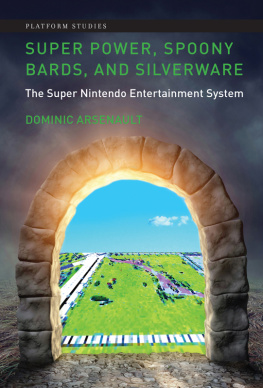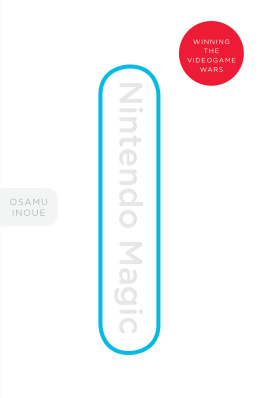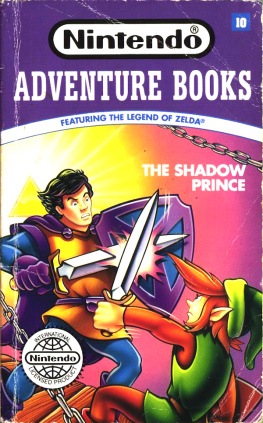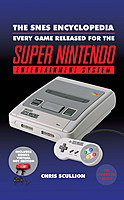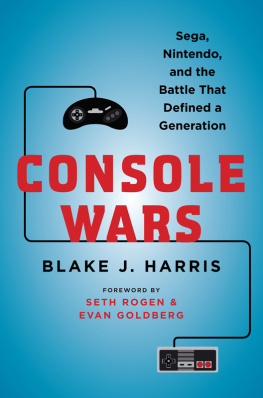
Platform Studies
Nick Montfort and Ian Bogost, editors
Racing the Beam: The Atari Video Computer System, Nick Montfort and Ian Bogost, 2009
Codename Revolution: The Nintendo Wii Platform, Steven E. Jones and George K. Thiruvathukal, 2012
The Future Was Here: The Commodore Amiga, Jimmy Maher, 2012
Flash: Building the Interactive Web, Anastasia Salter and John Murray, 2014
I AM ERROR: The Nintendo Family Computer / Entertainment System Platform, Nathan Altice, 2015
Peripheral Vision: Bell Labs, the S-C 4020, and the Origins of Computer Art, Zabet Patterson, 2015
Now the Chips Are Down: The BBC Micro, Alison Gazzard, 2016
Minitel: Welcome to the Internet, Julien Mailland and Kevin Driscoll, 2017
Super Power, Spoony Bards, and Silverware: The Super Nintendo Entertainment System, Dominic Arsenault, 2017
Super Power, Spoony Bards, and Silverware
The Super Nintendo Entertainment System
Dominic Arsenault
The MIT Press
Cambridge, Massachusetts
London, England
2017 Massachusetts Institute of Technology
All rights reserved. No part of this book may be reproduced in any form by any electronic or mechanical means (including photocopying, recording, or information storage and retrieval) without permission in writing from the publisher.
This book was set in Filosofia OT by Toppan Best-set Premedia Limited. Printed and bound in the United States of America.
Library of Congress Cataloging-in-Publication Data
Names: Arsenault, Dominic, author.
Title: Super Power, Spoony Bards, and Silverware : the Super Nintendo Entertainment System / Dominic Arsenault.
Description: Cambridge, MA : The MIT Press, 2017. | Series: Platform studies | Includes bibliographical references and index.
Identifiers: LCCN 2016055172 | ISBN 9780262036566 (hardcover : alk. paper)
eISBN 9780262341486
Subjects: LCSH: Nintendo video games--History. | Nintend Kabushiki Kaisha. | Nintendo of America Inc. | Video games industry--History.
Classification: LCC GV1469.32 .A76 2017 | DDC 794.809--dc23 LC record available at https://lccn.loc.gov/2016055172
ePub Version 1.0
Series Foreword
How can someone create a breakthrough game for a mobile phone or compelling work of art for an immersive 3D environment without understanding that the mobile phone and the 3D environment are different sorts of computing platforms? The best artists, writers, programmers, and designers are well aware of how certain platforms facilitate certain types of computational expression and innovation. Likewise, computer science and engineering have long considered how underlying computing systems can be analyzed and improved. As important as scientific and engineering approaches are, and as significant as work by creative artists has been, there is also much to be learned from the sustained, intensive, humanistic study of digital media. We believe it is time for humanists to seriously consider the lowest level of computing systems and their relationship to culture and creativity.
The Platform Studies series has been established to promote the investigation of underlying computing systems and of how they enable, constrain, shape, and support the creative work that is done on them. The series investigates the foundations of digital mediathe computing systems, both hardware and software, that developers and users depend upon for artistic, literary, and gaming development. Books in the series will certainly vary in their approaches, but they will all share certain features:
- a focus on a single platform or a closely related family of platforms
- technical rigor and in-depth investigation of how computing technologies work
- an awareness of and a discussion of how computing platforms exist in a context of culture and society, being developed on the basis of cultural concepts and then contributing to culture in a variety of waysfor instance, by affecting how people perceive computing.
Acknowledgments
Writing this book has taken a number of years, and although Ive been alone in penning the words, the long journey of ideas, from vague intuitions to rough shaping to constant chiseling and their final stonecast presence, could never have happened without the excellent people who have surrounded me through these years. I want to thank everyone who has engaged with my hypotheses, listened to my ramblings, and offered support in every way possible. In particular, and although mortally afraid to forget someone, Id like to thank first Andranne and Nathan, for being there for me and putting up with me while I rattled away at my keyboard for impossible hours; my close friends and colleagues in the Montreal game studies community, whom I always look forward to seeing, even if that doesnt happen enough: Bernard Perron, for his friendship, support, encouragements and wise advice; Maude Bonenfant, for the inspiring discussions and rich exchanges we keep having; Carl Therrien, Guillaume Roux-Girard, and Simon Dor, for their sustained, positive presence through the years; Martin Picard, for sending me charts and news and sharing ideas during writing (and beyond); Gabrielle Trpanier-Jobin, Louis-Martin Guay, and Danny Godin, for the all-too-rare occasions to meet and their ongoing friendship; Andrane Morin-Simard and Marc Joly-Corcoran, for their almost daily presence in the office and pleasant exchanges, as well as our academic collaborations; my LUDOV colleagues and friends Hugo Montembeault, Pascale Thriault, Mikal Julien, and Francis Lavigne; my research assistants of Team INTEGRAE Audrey Larochelle, Pierre-Marc Ct, and Sacha Lebel, who were tremendously helpful, dedicated, and perspicacious and who gave an additional dimension to my initially modest research project; MITP acquisitions editor Douglas Sery for his initial support and ongoing understanding and patience in making this project a reality; series editors Nick Montfort and Ian Bogost for their openness, support, and insightful comments on my initial pitch and first draft (Id say your comments were pure silver!); the two anonymous peer reviewers, whose excellent and generous work has been incredibly helpful in powering up this book from the initial draft; MITP manuscript workflow assistant Elizabeth Agresta for her keen eyes that saved the figures in chapter 7; Devin Monnens and John Szczepaniak for offering connections and encouragements; Akinori Nakamura and Koichi Hosoi for their kind and positive responses to my probably impolite emails; Dana Plank and Julianne Grasso for revising some of the music-oriented statements in the book (and for headbanging with me to the Final Fantasy Mystic Quest soundtrack); David Viens and Hubert Lamontagne of Plogue Art et technologie for revisions on audio technology; the Fonds de Recherche du QubecSocit et Culture (FRQSC) for funding my research project on innovation and graphical technologies in the video game industry; and finally the hordes of anonymous individuals and communities all over the Internet who have provided me innumerable references, trails to follow, and points to argue. I cant retrace all my digital footsteps, but I want to underline in particular the following portals: Wikipedia, the VGSales Wikia, VGchartz, N-Sider, SNES Central, Chris Covell, gamepilgrimage, MobyGames, 1up.com, Kotaku, the Super Nintendo Development Wiki, and the NESDev Forums.
Introduction: Welcome to the Dark Side
This book is about the Super NESmore precisely, it is a book about a certain framing of the Super NES as the technological enforcer of economic and cultural corporate wars in the video game industry. This book is about Nintendo, how it lived the 16-bit console wars of 19891995, and why it went from great to good to bad to worse in the span of 20 years. Ultimately, it is a critical history of Nintendos fall from grace, from the height of the Golden Age brought by its 8-bit NES console (19851990) through a waning Silver Age with its 16-bit Super NES (19901996) that ultimately led to a prolonged Dark Age with the Nintendo 64 and GameCube consoles (19962006). The bulk of the Super NESs lifespan is thus intricately tied to Nintendos Silver Age, when things began to go wrong for the firm.
Next page
